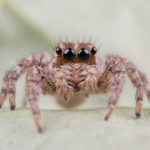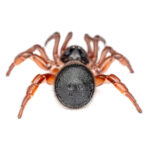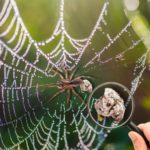The female wolf spiders store their eggs in a silk sac. The spinnerets fasten to the sac, which are near the back of the abdomen. The name of the silk sac is “egg sac” or cocoon because of its shape like a ball. The spider carries this sac and is a characteristic of wolf spider reproduction. The pregnant wolf spider carries the silk sac with her wherever she goes after mating and lays her eggs in it. Until the spiderlings hatch, the female carries the sac and protects the eggs. The spiderlings jump onto their mother’s back as soon as they emerge and remain there for a while before scattering.
Generally, mammals get “pregnant”. In the case of spiders, the name of the process is “gravid” or egg-carrying. Most people recommend keeping a distance if you come across a wolf spider carrying an egg sac because some wolf spider species are protective of their eggs and may act defensively if they feel threatened.
Until they hatch, pregnant wolf spiders carry their young on their backs. This is a really unusual method for a spider to carry its eggs. This page will reveal fascinating information on when baby wolf spiders arrive, how many babies a wolf spider can carry at once, whether or not they are hazardous, and whether or not people should harm or kill wolf spiders that are carrying young when they come into touch with them.
Spiders aren’t the only bugs that are in our homes, there are other insects too, find out more here.
Table of contents
Reproduction cycle of pregnant wolf spider
Given below are the stages a pregnant wolf spider goes through during pregnancy:
Mating
The mating rituals of adult male and female wolf spiders are distinguished by intricate wooing actions. The female becomes gravid (carrying eggs) after successful mating.

Egg Deposition
Usually formed like a ball, the female makes a silk sac and places her eggs inside of it. The spinnerets at the back of her abdomen hold the silk sac in place. Different species may lay different amounts of eggs.

Carrying the egg sac
The egg sac is carried by the pregnant wolf spider and is fastened to her spinnerets. The wolf spider is unique in its habits. She goes about her daily business as usual, but the egg sac is a noticeable feature.
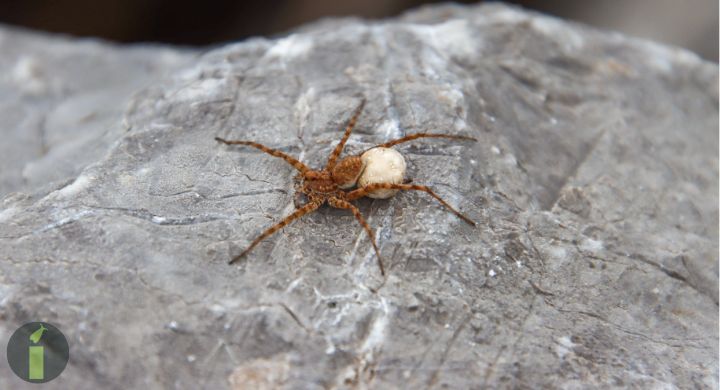
Spiderling hatching
The spiderlings emerge from the egg sac when they are ready to hatch. Certain species-specific characteristics and environmental conditions may influence the exact moment.

Maternal Care
The spiderlings climb onto their mother’s abdomen after hatching. In certain situations, the female aids in prey hunting and offers protection. The spiderlings benefit from the mother’s care throughout this stage of development.

Dispersal
The spiderlings gradually scatter as they become older and more self-sufficient. They have a higher likelihood of surviving during their early developmental phases because of the mother’s care.
You can find more details about pregnant spiders.
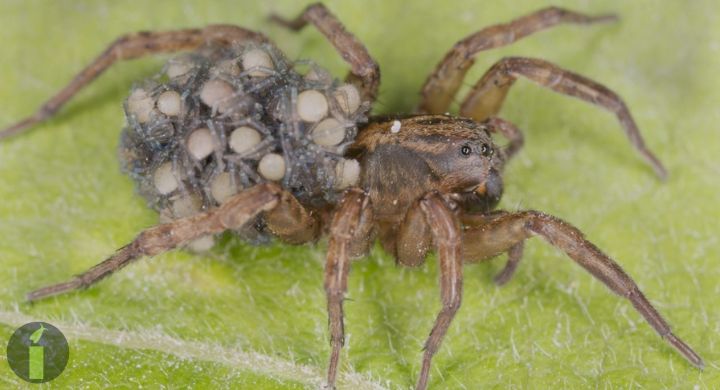
The appearance of wolf spider babies
When the pregnant wolf spiders give birth to babies they may be tan, grey, or black with dark inscriptions on their skins. Usually, these markings are stripes. They are better at camouflaging thanks to their body color, which helps them hunt and trap their prey. Additionally, it protects them from predators by making them blind and difficult to locate in bushes, fields, etc. They start off as small as 1 mm and gradually become more noticeable. Generally speaking, female spiders are smaller than male ones. Wolf spiders are the largest non-webbing spiders in North Carolina, according to NCSU research.
These spiders’ unusual eye configuration is another characteristic that sets them apart. Four tiny eyes that are in a straight row and are almost the same size and shape make up the front row, also known as the anterior row. On the other hand, the posterior or back has a shape like a V. In addition, the apex is directly adjacent to the anterior row. Wolf spiders have the extraordinary ability to see well at night. Since it is more comfortable to hunt in the dark, they prefer to do so at night. However, wolf spiders’ eyeshine, which only shows in the dark, makes them easy to spot at night, which is a drawback.

How many babies can a pregnant wolf spider have?
A pregnant wolf spider seeks total isolation after pregnancy. The pregnant wolf spider would locate a protected, covered area to lay her eggs. It desires to protect her offspring, just like any other mother. Every time a wolf spider mates, it will deposit close to 100 eggs. The mother covers the eggs with a silk sac, which shields them from harm and offers minimal nourishment. The pregnant wolf spider fiercely guards the eggs. When they move in spherical sacs on their spinnerets, they can be somewhat defensive because they are carrying the eggs.
The pregnant wolf spider cracks open the sac to release her spiderlings when the time comes for the spider eggs to develop. For safety and sustenance, the young spiderlings cling to their mother’s body and legs. The spiderlings split off from their mother’s body after a few weeks and begin to fend for themselves.
Are Young Wolf Spiders Harmful?
Based on statistical analysis and study, spiders are not inherently hostile or vindictive. However, this is only the case when they don’t feel a threat. In particular, wolf spiders are not as hazardous as other spiders worldwide. Wolf spider venom is not entirely lethal to humans. Additionally, wolf spider bites do not kill people. Usually, the bite wound heals in a few days on its own. However, if you find that the bite is getting worse or if you experience weird symptoms after it, we advise that you visit a doctor right away and obtain the right medication.
Should you kill a pregnant wolf spider?
Killing any living thing, no matter how terrified you are of it, is bad. In particular, you should not kill a pregnant wolf spider. A pregnant wolf spider can be quite vicious and dangerous to squash. Wolf spiders typically inhabit grassy, dirt, and leaf litter regions in large clusters numbering in the thousands. Wolf spiders enjoy hiding in the earth and soil, digging tunnels and holes. Additional habitats for wolf spiders include wood, covered spaces, underboards, and locations shielded by stones.
The young attempt to break free from their mother’s body and disperse everywhere when a pregnant wolf spider is crushed to death. It would be hard to stop them from scattering because they are so small and fast. There’s a chance the mother wolf spider will die, but in the end, there will be an increasing number of baby wolf spiders scattered throughout your home and yard.
Frequently Asked Questions (FAQs) about Pregnant Wolf Spider
Q1. What to do with a pregnant wolf spider?
Should you manage to capture a female spider carrying eggs, it might potentially release hundreds of spiderlings across your floor. If you come across a wolf spider in your house, use adhesive boards to catch it and remove it. You may get glue boards at agricultural supply stores. Or maybe catch it with a glass and paper and let it go outside.
Q2. Why do wolf spiders carry babies?
The mother wolf spider cracks open the sac to release her spiderlings when the time comes for the spider eggs to develop. For safety and sustenance, the young spiderlings cling to their mother’s body and legs. The spiderlings split off from their mother’s body after a few weeks and begin to fend for themselves.
Q3. Do wolf spiders lay eggs?
The female wolf spider looks for a secluded, covered area to lay her eggs after mating. The eggs that females lay, which they wrap in a silk sac, number at least 100. Unlike other spider species, wolf spiders carry these spherical sacs on their spinnerets and are protective of their eggs.
Q4. What is the lifespan of a wolf spider?
People often confuse them for tarantulas despite being largely nocturnal. If you consistently agitate wolf spiders, they will inject venom. Their poisonous bite causes swelling, itching, and moderate pain. Lifespan: Females survive 2-3 years, and males live less than a year.
Q5. Do wolf spiders give birth?
Following mating the pregnant wolf spider lays and collects eggs into a green egg sac following mating. When the eggs are ready to hatch, the mother helps open the sac so the young can escape by carrying the sac on her back. It’s possible that over 100 babies will hatch.



